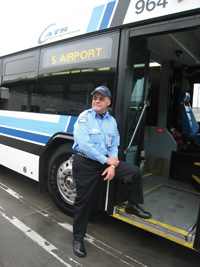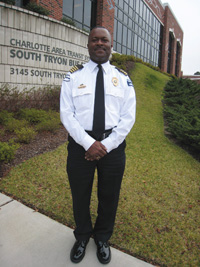|
By Peter Hildebrandt With a mission to improve the quality of life for all in the greater Charlotte, N.C., area, this city’s transit system is proud of both its brand new light-rail service, LYNX, and the distinctive uniforms of the employees. Charlotte has had a transit system since the early 1900s. The Charlotte Area Transit System (CATS) now consists of its buses and, as of 2007, the LYNX Light Rail Line. In this growing area of the country and one of the most progressive states in the Southeast, CATS serves the entire Charlotte area, including service into the surrounding counties of Union, Lincoln, York, Cabarrus, Gaston and Iredell. As North Carolina’s first light-rail line, LYNX has been a huge success, according to Krystel Green, senior transit marketing representative, who also acts as the marketing liaison between CATS and the contractor running the Charlotte bus service. The CATS bus service is operated and maintained by a separate company, Transit Management of Charlotte. The reason for this is that the bus drivers and the bus line mechanics are unionized, and by state law, government entities do not negotiate with unions. The new light-rail services and special transportation services workers are actually city employees. Buses started service in the Charlotte area in the early 1900s, according to Green. The official name of Charlotte Area Transit System was established in 2000. “Today our system has more than 75 routes that service Charlotte and surrounding counties. CATS provided more than 23 million rides for guests during the 2008 fiscal year [July 2007 through June 2008].” As with many other cities throughout the country, Charlotte’s buses came on line in the 1930s. The city also had trolleys. The system’s uniform program has been in place for many years too. The bus driver and light-rail operator uniforms are similar though they are not exactly the same. “We wanted everyone to have a consistent look but didn’t feel they had to be exactly the same,” says Green. “This consistency reminds citizens that everyone operating CATS services has a common goal to get people to their destination safely and in a timely manner while providing an enjoyable experience.” There are several uniform options from which bus drivers can choose. Female drivers have the option of wearing skirts if they would like. In the summer, workers have the choice of wearing a short-sleeve polo shirt with the Charlotte Area Transit System logo or the long-sleeve light blue shirt. There is also a short-sleeve button-down shirt as well as jackets, sweaters and lots of other choices to allow bus drivers to select the uniform that is most comfortable and fits the weather. Uniforms are supplied by Best Uniform Co. The system has more than 600 bus drivers and about 150 maintenance employees. The maintenance department has a separate program that is administered by another uniform company. Fixed Route Operators CATS operators and supervisors have many options for their uniforms, however everyone must wear a nametag. The uniforms for men in this group include navy blue cotton pants and light blue, short-sleeve button-down dress shirts. Their light blue, long-sleeve button-down shirts must be worn with a traditional, navy blue tie unless a dickey is worn underneath. The colors available for polo shirts are light blue or navy blue, and both are short sleeve. These are only worn during the summer months. For employees wearing vests, the only color used is navy blue. Outerwear options include sweaters, which are navy blue and available in button-down, zippered or pullover. Jackets are worn in the coldest months, and raincoats are standard issue for those rainy days. Shoes can be purchased from any retailer but must be black leather. Each employee receives a set of six shirts, two pairs of pants, one tie, one hat, one coat and one sweater as a complete uniform package. CATS employees also have the option of purchasing additional uniform pieces through the use of an annual uniform allowance. “We don’t really find ourselves revamping the uniform program too often,” says Green. “It is changed as needed. However, changes must be agreed upon by both the company and the union. Perhaps one of the factors in keeping things relatively consistent is how the public has received the uniform program overall. They’ve given us a positive response to the operators’ appearance. Citizens have said they look professional; that’s always nice feedback to garner.” Other components of the uniforms include hats and gloves. Every operator can wear a policeman-style hat or a navy blue CATS-logo baseball cap. Employees may also choose to wear black gloves in the course of their work. These do not have to be obtained through the uniform company. Women are permitted to wear the same pieces as men but have additional choices as well. These include skirts, navy blue woman’s ties and hats similar to those worn by the men. Women may also wear a navy blue beret if they choose. For paratransit operators, dress consists of navy blue cotton pants, white button-down dress shirts with bow tie or a full tie, and red vests. CATS supervisors are fitted with navy blue cotton pants and white dress shirts containing boards on the shoulders. Also for supervisors, badges are worn on the right chest and their name tags on the left. Nearby Service a Plus Best Uniform Co., which coordinates the uniforms for CATS, has been operating since 1990. It serves mainly North Carolina, some areas in Virginia up to Richmond and some locations in South Carolina as well. Though the number of accounts it has varies from year to year, typically Best Uniform has some 300 accounts. The company prides itself on being a relatively small, family-owned company with a family-owned environment, according to Marcus Misenheimer, vice president of sales. “Ours isn’t a corporate culture, but more of a smaller company feel. We are a supplier or vendor dealing with many manufacturers. “Many times, a business goes out on bids that vendors like ourselves will bid on, and if we receive the bid we will purchase the uniforms from a company such as Fechheimer and supply them to the end user. We do the work of measuring people and custom-tailoring the uniforms, doing lots of alterations on them. This includes hems, patching shirts or adding striping to the garments just about everything except actually manufacturing the garments.” About 90 percent of Best Uniform’s business is in public safety and law enforcement, including fire protection workers and EMS personnel. It does some uniforms for the hospitality and medical industries as well as the uniforms for security personnel at the Charlotte Airport. Airport security is part of the Charlotte-Mecklenburg Police Department, though airport personnel wear a slightly different uniform than the regular police. Best Uniform has had to tailor what’s available for the Southeast climate it primarily supplies. A lot of tropical-blend fabrics are used, which breathe well in summer but don’t get too cold in the winter. The CATS employees wear what may be considered more of a public safety-style shirt, according to Misenheimer. It has shoulder epaulets, special pockets, military creases and other features making the style more military in nature. An assortment of patches is used by CATS, and Best Uniform supplies a number of these to them. “We do some unique things for the transit system,” adds Misenheimer. “Each year they’ve won the ‘Safest Transit in the State Award’ from North Carolina, involving the addition of a new chevron patch on one sleeve. It’s going on 10 to 15 years now that they’ve won the award, and we’ve been supplying it for the left sleeve.” A Place for Fittings Best Uniform has a storefront in Charlotte with six dressing rooms and a staff that works the sales floors. “As customers come in with requisitions or to spend money, they are fitted here, and we do the alterations,” says Misenheimer. “Much of the time we can do the alterations especially on pants while they wait.” Larger departments will go for a scheduled fitting done onsite. But for an individual or when the hiring classes graduate 20 or so new employees, it works well for them to arrive at the shop in the morning and have alterations done. Unlike some rental-type uniform companies, Best Uniform does not do any servicing such as uniform cleanings. It will do repairs as needed. If a button turns up missing, the uniform may be brought in, and the garment will be returned to the user after being repaired. “Most all of the uniforms we supply are machine-washable. Some still request the dry-cleanable only uniforms as well,” says Misenheimer. “We don’t have a need to revamp the uniform program very often. A lot of time with our business, when a new head of a law enforcement agency starts out, they will want to change things a bit to make it their own. That’s the time when we try to work with the client and do what needs to be done to keep things going smoothly.” Misenheimer points to the work they’ve done with the Charlotte-Mecklenburg Police Department, another client of which they are proud. For the police department, Best put together a completely customized program to serve their needs. “We work hand in hand with the manufacturers, right up to the point where the uniforms are on their backs and they’re walking down the street,” says Misenheimer. “Though the police and CATS are very different in function, things are quite similar in how both of those accounts are serviced. With all our accounts, our service aspect at Best Uniform Company is something we truly pride ourselves on.” To stay ahead of the curve, Best Uniform has been involved with the North-American Association of Uniform Manufacturers and Distributors. For the growing city of Charlotte and its transit employees, a local uniform company has worked out to be a good fit for all involved. |
|
| Above story first appeared in MADE TO MEASURE Magazine, Spring & Summer 2009 issue. All rights reserved. Photos appear by special permission. | |
| Halper Publishing Company 633 Skokie Blvd, #490 Northbrook, IL 60062 (877) 415-3300 Fax (224) 406-8850 [email protected] |
|













